How Does Blue Infrastructure Affect the Attractiveness Rating of Residential Areas? Case Study of Olsztyn City, Poland
Abstract
1. Introduction
2. Literature Overview—Diagnosis of Urban Design and Water Management
3. Materials and Methods
3.1. Study Area
- i.
- Construction of ul. Towarowa—from the intersection of Towarowa Street and Leonharda Street to the Wschód Junction (S51);
- ii.
- Reconstruction of Partyzantów Street;
- iii.
- Reconstruction of Pieniężnego Street along with the St. Jacob’s Bridge;
- iv.
- Transfer junction at the railway/bus station;
- v.
- Extension of provincial road No. 598—Płoskiego/Witosa/Bukowskiego/Jaroty (S51);
- vi.
- Construction of a tram line from Pieczewo to the city center;
- vii.
- Construction of a new Olsztyn Główny railway station.
3.2. Research Framework
3.3. Geo-Questionnaire Design
3.4. Blue Infrastructure Inventory
- i.
- Water body number;
- ii.
- Information on whether the area is private;
- iii.
- Water body accessibility, understood as the possibility of physical access to the water/shore of the water body, unrelated to ownership (0 points—no access; 1 point—partial access; 2 points—full access). Reservoir accessibility was also assessed based on the ‘density of roads, paths, cycling paths’ [59], as well as ‘the accessibility of shores,’ ‘the accessibility and size of the water surface,’ and ‘the seasonal stability of the water surface’ [61].
- iv.
- Recreational function (0 points—absent; 0.5 points—water body with potential for recreational use, offering space for public use; 1 point—partially realized recreational function outside the water body—at least one activity such as fishing, cycling, rollerblading, sunbathing, etc.; 1 point—partially realized recreational function within the water body—at least one activity such as swimming, use of water equipment such as kayaks, sailboats, boats; 2 points—full recreational function both outside and within the water body). The assessment of recreational activities related to water bodies was conducted by L’Ecuyer-Sauvageau et al. [62] who, following Savard (2005), listed all activities, swimming, and none. Moreover, the recreational function was assessed in terms of the ‘variety in landscapes with (potential) recreational uses’ [27]. In other studies [59], the recreational function of reservoirs concerned the definition of the ‘number of areas for recreation’ (assessed as high, medium, low). Subsequent research [61] focused on identifying the following elements: ‘beaches; cultural programme; equipment for team games; water and land (hiking, skiing, walking, and horse riding); tourist trails, nature trails; sailing; permanent and temporary bathing beaches; diving; canoeing; powerboating; fishing.’ In addition, the recreational function understood as ‘preventive healthcare; well-being, leisure and hobby’ was analyzed by Józefowicz et al. [63];
- v.
- Ecological function (0 points—degraded water body; 1 point—undegraded water body, not requiring restoration). Similar research was performed by L’Ecuyer-Sauvageau et al. [62], who quoted Savard (2005), assessing the visual aspect of the water body as water clarity (opaque, troubled, clear water). They also rated water bodies based on ecological health as bad, intermediate, or good [26]. The cited studies also analyzed odor—the smell from the water body, such as: garbage, cut grass, none. However, our research did not take into account odor because if there was no access to a given reservoir, the assessment was based on available map data. A similar scale, but increased by cultural value near the shore, was proposed by Rzętała [61]. The ecological function was also analyzed in terms of biodiversity protection and regulation [63];
- vi.
- Educational function (0 points—absent; 1 point—educational paths or informational boards about the fauna and flora in the vicinity of the water body and its surroundings). The recreational function was also utilized by Józefowicz et al. [63].
- vii.
- Economic function (0 points—absent; 1 point—business establishments within 100–200 m from the water body—gastronomy, water equipment rental, accommodations, recreation and sports; 1 point—commercial or public transport and communication services: ferries, water trams). This approach aligns with the research methodology of L’Ecuyer-Sauvageau et al. [62], who, following Savard (2005), considered the annual increase in municipal tax to gauge economic contribution. Subsequent studies [61] extended the evaluation to include specific elements like ‘commercial and catering services, i.e., shops, restaurants’ and ‘accommodation facilities, i.e., private lodgings campsites, hostels, B&Bs, hotels, and motels.’ The economic function was further examined concerning the presence of investment and industrial elements [63];
- viii.
- Social function (0 points—absent; 1 point—publicly accessible spaces for social integration—at least one of the elements such as camping areas, places for bonfires, grills, shelters, benches). Pena et al. [59] analyzed social preferences for ‘different ecosystems and landscapes for recreation.’ They used the European Nature Information System (EUNIS) [64] and e-mail-in photo-questionnaires. In the case of the research that is the subject of this paper, it was not possible to use EUNIS, because its data concerning water reservoirs for the Warmia and Mazury Voivodeship, where Olsztyn is located, are too general and do not include information about most of the city’s reservoirs. Social function was also the subject of analysis by Józefowicz et al. [63];
- ix.
- Esthetic function (0 points—neglected water body without significant viewing points or with minimal ones, possibly polluted; 1 point—water body with moderate viewing points not emphasizing the beauty of the landscape; 2 points—water body with high esthetic value resulting from open view, cleanliness and neatness, mostly evoking positive emotions, pleasant experiences, and admiration in the observer). The esthetic function was assessed by considering two important factors: open view [65,66] and cleanliness and well-kept surroundings [67]. Esthetic information, such as the attractiveness of landscape features, was evaluated as ‘Enjoyment of scenery (e.g., scenic roads, housing)’ [29]. Esthetic value was also assessed by evaluating ‘water quality’ and ‘esthetic values of the vicinity’ [61].
- Inventory on a map with the use of the topographic objects database (BDOT10k), which consisted of determining the coverage of individual water bodies (flowing, standing) and utilizing high-resolution orthophoto maps provided by the Main Office of Geodesy (Figure 4);
- Field inventory consisted of visual assessment and photographic documentation. It was a necessary step to verify the current accuracy of available cartographic documentation.
3.5. A Process of Geo-Analysis
4. Results
4.1. Geo-Survey Results
4.2. Parametric Evaluation of Water Bodies
4.3. Evaluation of Residential Neighborhoods
5. Discussion
6. Conclusions
Author Contributions
Funding
Institutional Review Board Statement
Informed Consent Statement
Data Availability Statement
Conflicts of Interest
References
- United Nations. Transforming Our World: The 2030 Agenda for Sustainable Development. 2015. Available online: https://sdgs.un.org/2030agenda (accessed on 17 November 2023).
- Gleason, J.A.; Casiano Flores, C. Challenges of Water Sensitive Cities in Mexico: The Case of the Metropolitan Area of Guadalajara. Water 2021, 13, 601. [Google Scholar] [CrossRef]
- Gimenez-Maranges, M.; Breuste, J.; Hof, A. Sustainable Drainage Systems for Transitioning to Sustainable Urban Flood Management in the European Union: A Review. J. Clean. Prod. 2020, 255, 120191. [Google Scholar] [CrossRef]
- Cotterill, S.; Bracken, L.J. Assessing the Effectiveness of Sustainable Drainage Systems (SuDS): Interventions, Impacts and Challenges. Water 2020, 12, 3160. [Google Scholar] [CrossRef]
- Brears, R.C. Blue and Green Cities: The Role of Blue-Green Infrastructure in Managing Urban Water Resources; Palgrave Macmillan: London, UK, 2018; ISBN 978-1-137-59257-6. [Google Scholar]
- Antoszewski, P.; Świerk, D.; Krzyżaniak, M. Statistical Review of Quality Parameters of Blue-Green Infrastructure Elements Important in Mitigating the Effect of the Urban Heat Island in the Temperate Climate (C) Zone. Int. J. Environ. Res. Public Health 2020, 17, 7093. [Google Scholar] [CrossRef]
- Lin, Y.; Wang, Z.; Jim, C.Y.; Li, J.; Deng, J.; Liu, J. Water as an Urban Heat Sink: Blue Infrastructure Alleviates Urban Heat Island Effect in Mega-City Agglomeration. J. Clean. Prod. 2020, 262, 121411. [Google Scholar] [CrossRef]
- Badach, J.; Szczepański, J.; Bonenberg, W.; Gębicki, J.; Nyka, L. Developing the Urban Blue-Green Infrastructure as a Tool for Urban Air Quality Management. Sustainability 2022, 14, 9688. [Google Scholar] [CrossRef]
- Kadaverugu, R.; Dhyani, S.; Dasgupta, R.; Kumar, P.; Matli, C. Urban Sustainability and Resilience Building: Blue-Green Infrastructure for Air Pollution Abatement and Realizing Multiple Co-Benefits. In Blue-Green Infrastructure Across Asian Countries; Springer: Singapore, 2022; pp. 397–417. ISBN 9789811671272. [Google Scholar]
- Drosou, N.; Soetanto, R.; Hermawan, F.; Chmutina, K.; Bosher, L.; Hatmoko, J.U.D. Key Factors Influencing Wider Adoption of Blue–Green Infrastructure in Developing Cities. Water 2019, 11, 1234. [Google Scholar] [CrossRef]
- Koop, S.H.A.; Koetsier, L.; Doornhof, A.; Reinstra, O.; Van Leeuwen, C.J.; Brouwer, S.; Dieperink, C.; Driessen, P.P.J. Assessing the Governance Capacity of Cities to Address Challenges of Water, Waste, and Climate Change. Water Resour. Manag. 2017, 31, 3427–3443. [Google Scholar] [CrossRef]
- O’Donnell, E.; Thorne, C.; Ahilan, S.; Arthur, S.; Birkinshaw, S.; Butler, D.; Dawson, D.; Everett, G.; Fenner, R.; Glenis, V.; et al. The Blue-Green Path to Urban Flood Resilience. Blue-Green Syst. 2019, 2, 28–45. [Google Scholar] [CrossRef]
- Andreucci, M.B.; Russo, A.; Olszewska-Guizzo, A. Designing Urban Green Blue Infrastructure for Mental Health and Elderly Wellbeing. Sustainability 2019, 11, 6425. [Google Scholar] [CrossRef]
- Syrbe, R.-U.; Neumann, I.; Grunewald, K.; Brzoska, P.; Louda, J.; Kochan, B.; Macháč, J.; Dubová, L.; Meyer, P.; Brabec, J.; et al. The Value of Urban Nature in Terms of Providing Ecosystem Services Related to Health and Well-Being: An Empirical Comparative Pilot Study of Cities in Germany and the Czech Republic. Land 2021, 10, 341. [Google Scholar] [CrossRef]
- Bustamante, G.; Guzman, V.; Kobayashi, L.C.; Finlay, J. Mental Health and Well-Being in Times of COVID-19: A Mixed-Methods Study of the Role of Neighborhood Parks, Outdoor Spaces, and Nature among US Older Adults. Health Place 2022, 76, 102813. [Google Scholar] [CrossRef] [PubMed]
- Pouso, S.; Borja, Á.; Fleming, L.E.; Gómez-Baggethun, E.; White, M.P.; Uyarra, M.C. Contact with Blue-Green Spaces during the COVID-19 Pandemic Lockdown Beneficial for Mental Health. Sci. Total Environ. 2021, 756, 143984. [Google Scholar] [CrossRef]
- Williams, J.B.; Jose, R.; Moobela, C.; Hutchinson, D.J.; Wise, R.; Gaterell, M. Residents’ Perceptions of Sustainable Drainage Systems as Highly Functional Blue Green Infrastructure. Landsc. Urban Plan. 2019, 190, 103610. [Google Scholar] [CrossRef]
- Mumtaz, M. Role of Civil Society Organizations for Promoting Green and Blue Infrastructure to Adapting Climate Change: Evidence from Islamabad City, Pakistan. J. Clean. Prod. 2021, 309, 127296. [Google Scholar] [CrossRef]
- Kronenberg, J.; Haase, A.; Łaszkiewicz, E.; Antal, A.; Baravikova, A.; Biernacka, M.; Dushkova, D.; Filčak, R.; Haase, D.; Ignatieva, M.; et al. Environmental Justice in the Context of Urban Green Space Availability, Accessibility, and Attractiveness in Postsocialist Cities. Cities 2020, 106, 102862. [Google Scholar] [CrossRef]
- Cucca, R.; Thaler, T. Social Justice in the Green City. Urban Plan. 2023, 8, 279–282. [Google Scholar] [CrossRef]
- Brown, J.; Acey, C.S.; Anthonj, C.; Barrington, D.J.; Beal, C.D.; Capone, D.; Cumming, O.; Pullen Fedinick, K.; MacDonald Gibson, J.; Hicks, B.; et al. The Effects of Racism, Social Exclusion, and Discrimination on Achieving Universal Safe Water and Sanitation in High-Income Countries. Lancet Glob. Health 2023, 11, e606–e614. [Google Scholar] [CrossRef]
- Palliwoda, J.; Haase, A.; Suppee, C.; Rink, D.; Priess, J. Visions for Development and Management of Urban Green and Blue Infrastructure: A Citizen’s Perspective. Ecol. Soc. 2022, 27, 8. [Google Scholar] [CrossRef]
- Grellier, J.; White, M.P.; Albin, M.; Bell, S.; Elliott, L.R.; Gascón, M.; Gualdi, S.; Mancini, L.; Nieuwenhuijsen, M.J.; Sarigiannis, D.A.; et al. BlueHealth: A Study Programme Protocol for Mapping and Quantifying the Potential Benefits to Public Health and Well-Being from Europe’s Blue Spaces. BMJ Open 2017, 7, e016188. [Google Scholar] [CrossRef]
- Kantor-Pietraga, I.; Krzysztofik, R.; Solarski, M. Planning Recreation around Water Bodies in Two Hard Coal Post-Mining Areas in Southern Poland. Sustainability 2023, 15, 10607. [Google Scholar] [CrossRef]
- Józefowicz, I.; Michniewicz-Ankiersztajn, H. Green and Blue Spaces as the Area for Residential Investments in a Modern City—Example of Bydgoszcz (Poland). Geogr. Tour. 2020, 8, 85–96. [Google Scholar] [CrossRef]
- Breś, J. Influence of Blue Infrastructure on Shaping Urban Blue Space. Biul. KPZK 2019, 276, 43–55. [Google Scholar]
- Zwierzchowska, I.; Haase, D.; Dushkova, D. Discovering the Environmental Potential of Multi-Family Residential Areas for Nature-Based Solutions. A Central European Cities Perspective. Landsc. Urban Plan. 2021, 206, 103975. [Google Scholar] [CrossRef]
- Dawidowicz, A.; Dudzińska, M. The Potential of GIS Tools for Diagnosing the SFS of Multi-Family Housing towards Friendly Cities—A Case Study of the EU Member State of Poland. Sustainability 2022, 14, 6642. [Google Scholar] [CrossRef]
- Baró, F.; Haase, D.; Gómez-Baggethun, E.; Frantzeskaki, N. Mismatches between Ecosystem Services Supply and Demand in Urban Areas: A Quantitative Assessment in Five European Cities. Ecol. Indic. 2015, 55, 146–158. [Google Scholar] [CrossRef]
- Nikodinoska, N.; Paletto, A.; Pastorella, F.; Granvik, M.; Franzese, P.P. Assessing, Valuing and Mapping Ecosystem Services at City Level: The Case of Uppsala (Sweden). Ecol. Model. 2018, 368, 411–424. [Google Scholar] [CrossRef]
- Water Quality Assessments: A Guide to the Use of Biota, Sediments and Water in Environmental Monitoring, 2nd ed.; Chapman, D.V., Ed.; CRC Press: London, UK, 2021; ISBN 978-1-00-306210-3. [Google Scholar]
- van der Meulen, E.S.; van Oel, P.R.; Rijnaarts, H.H.M.; Sutton, N.B.; van de Ven, F.H.M. Suitability Indices for Assessing Functional Quality of Urban Surface Water. City Environ. Interact. 2022, 13, 100079. [Google Scholar] [CrossRef]
- Li, J.; Huang, L.; Zhu, K. Ecological Health Assessment of an Urban River: The Case Study of Zhengzhou City, China. Sustainability 2023, 15, 8288. [Google Scholar] [CrossRef]
- Kimic, K.; Ostrysz, K. Assessment of Blue and Green Infrastructure Solutions in Shaping Urban Public Spaces—Spatial and Functional, Environmental, and Social Aspects. Sustainability 2021, 13, 11041. [Google Scholar] [CrossRef]
- Langie, K.; Rybak-Niedziółka, K.; Hubačíková, V. Principles of Designing Water Elements in Urban Public Spaces. Sustainability 2022, 14, 6877. [Google Scholar] [CrossRef]
- Kuzniecow Bacchin, T.; Ashley, R.; Sijmons, D.; Zevenbergen, C.; Timmeren, A. Green-Blue Multifunctional Infrastructure: An Urban Landscape System Design New Approach. In Proceedings of the 13th International Conference on Urban Drainage, Sarawak, Malaysia, 7–12 September 2014. [Google Scholar]
- ISO 37120:2018. Sustainable Cities and Communities—Indicators for City Services and Quality Of Life. ISO: Geneva, Switzerland, 2018. Available online: https://www.iso.org/standard/68498.html (accessed on 8 September 2023).
- Sharma, A.K.; Pezzaniti, D.; Myers, B.; Cook, S.; Tjandraatmadja, G.; Chacko, P.; Chavoshi, S.; Kemp, D.; Leonard, R.; Koth, B.; et al. Water Sensitive Urban Design: An Investigation of Current Systems, Implementation Drivers, Community Perceptions and Potential to Supplement Urban Water Services. Water 2016, 8, 272. [Google Scholar] [CrossRef]
- Gianferrara, E.; Boshoff, J. The PERFECT (Planning for Environment and Resource Efficiency in European Cities and Towns) Project—Expert Paper 1: Health, Wealth and Happiness—The Multiple Benefits of Green Infrastructure; Town and Country Planning Association: London, UK, 2018. [Google Scholar]
- Well, F.; Ludwig, F. Blue–Green Architecture: A Case Study Analysis Considering the Synergetic Effects of Water and Vegetation. Front. Archit. Res. 2020, 9, 191–202. [Google Scholar] [CrossRef]
- Noszczyk, T.; Gorzelany, J.; Kukulska-Kozieł, A.; Hernik, J. The Impact of the COVID-19 Pandemic on the Importance of Urban Green Spaces to the Public. Land Use Policy 2022, 113, 105925. [Google Scholar] [CrossRef]
- Ingenieur-, Architektur- und Managementberatung—Ramboll Group. Available online: https://www.ramboll.com/de-de (accessed on 17 November 2023).
- Poland in Numbers (Polska w Liczbach). Available online: https://www.polskawliczbach.pl/Olsztyn (accessed on 17 November 2023).
- Municipal Survey and Cartographic Documentation Centre. Available online: https://modgik.olsztyn.eu/ (accessed on 15 January 2023).
- Olsztyn Municipal Office. Location of Olsztyn—Visit Olsztyn. Available online: https://visit.olsztyn.eu/en/article/85/location-of-olsztyn (accessed on 17 November 2023).
- Olsztyn Municipal Office. Environmental Protection Programme for the City of Olsztyn by 2024 with an Outlook to 2030. 2023. Available online: https://olsztyn.eu/fileadmin/katalogi_wydzialowe/gospodarka/dokumenty%20strategiczne/Program_Ochrony_Srodowiska_2024.pdf (accessed on 10 November 2023).
- Olsztyn Municipal Office. Investments. Available online: https://olsztyn.eu/gospodarka/inwestycje.html (accessed on 17 November 2023).
- Olsztyn Municipal Office. City Development Strategy—Olsztyn 2030+. Available online: https://olsztyn.eu/gospodarka/dokumenty-strategiczne/strategia-rozwoju-miasta.html (accessed on 17 November 2023).
- Olsztyn Daily Newspaper. Well Advanced Works on a Key Investment for Olsztyn. A Modern Eco-Power Plant Is Being Built at Bublewicza Street (Zaawansowane Prace Nad Kluczową Inwestycją Dla Olsztyna. Przy Ulicy Bublewicza Powstaje Nowoczesna Ekociepłownia). Available online: https://gazetaolsztynska.pl/903147,Zaawansowane-prace-nad-kluczowa-inwestycja-dla-Olsztyna-Przy-ulicy-Bublewicza-powstaje-nowoczesna-ekocieplownia.html (accessed on 17 November 2023).
- Olsztyn Citizens’ Budget (Olsztyński Budżet Obywatelski). Available online: https://glosujobo.olsztyn.eu/index.php/projekty (accessed on 4 December 2023).
- Figurska, M.; Dawidowicz, A.; Zysk, E. Voronoi Diagrams for Senior-Friendly Cities. Int. J. Environ. Res. Public Health 2022, 19, 7447. [Google Scholar] [CrossRef] [PubMed]
- Kahn, P.H. The Human Relationship with Nature: Development and Culture; The MIT Press: Cambridge, MA, USA, 1999; ISBN 978-0-262-27666-5. [Google Scholar]
- Kelly, C.M.; Strauss, K.; Arnold, J.; Stride, C. The Relationship between Leisure Activities and Psychological Resources That Support a Sustainable Career: The Role of Leisure Seriousness and Work-Leisure Similarity. J. Vocat. Behav. 2020, 117, 103340. [Google Scholar] [CrossRef]
- Orr, P.; Colby, B. Nature-Oriented Visitors and Their Expenditures: Upper San Pedro River Basin; University of Arizona: Tucson, AZ, USA, 2022. [Google Scholar]
- Syme, G.J.; Porter, N.B.; Goeft, U.; Kington, E.A. Integrating Social Well Being into Assessments of Water Policy: Meeting the Challenge for Decision Makers. Water Policy 2008, 10, 323–343. [Google Scholar] [CrossRef]
- Ewert, A. Quality of Life, Recreation, and Natural Environments: Exploring the Connection. In Managing for Healthy Ecosystems; CRC Press: Boca Raton, FL, USA, 2002; ISBN 978-0-429-14323-6. [Google Scholar]
- White, M.P.; Elliott, L.R.; Gascon, M.; Roberts, B.; Fleming, L.E. Blue Space, Health and Well-Being: A Narrative Overview and Synthesis of Potential Benefits. Environ. Res. 2020, 191, 110169. [Google Scholar] [CrossRef]
- Smith, D.G.; Croker, G.F.; McFarlane, K. Human Perception of Water Appearance: 1. Clarity and Colour for Bathing and Aesthetics. N. Z. J. Mar. Freshw. Res. 1995, 29, 29–43. [Google Scholar] [CrossRef]
- Peña, L.; Casado-Arzuaga, I.; Onaindia, M. Mapping Recreation Supply and Demand Using an Ecological and a Social Evaluation Approach. Ecosyst. Serv. 2015, 13, 108–118. [Google Scholar] [CrossRef]
- Doherty, E.; Murphy, G.; Hynes, S.; Buckley, C. Valuing Ecosystem Services across Water Bodies: Results from a Discrete Choice Experiment. Ecosyst. Serv. 2014, 7, 89–97. [Google Scholar] [CrossRef]
- Rzętała, M. The New Evaluation Proposal of Tourist-Recreational Attractiveness of Water Reservoirs. In Proceedings of the 3rd International Multidisciplinary Scientific Conference on Socials Ciences & Arts SGEM, Albena, Bulgaria, 24 August 2016. [Google Scholar]
- L’Ecuyer-Sauvageau, C.; Kermagoret, C.; Dupras, J.; He, J.; Leroux, J.; Schinck, M.-P.; Poder, T.G. Understanding the Preferences of Water Users in a Context of Cyanobacterial Blooms in Quebec. J. Environ. Manag. 2019, 248, 109271. [Google Scholar] [CrossRef]
- Józefowicz, I.; MichniewiczAnkiersztajn, H.; Rurek, M. Functions of Blue Spaces of Anthropogenic Origin in Cities—The Example of Bydgoszcz. In Proceedings of the 3rd International Conference on Water Management and Its Surroundings—Theoretical and Practical Aspects, Olsztyn, Poland, 17–18 May 2023. [Google Scholar]
- European Environment Agency (EEA). EUNIS Database. Available online: https://eunis.eea.europa.eu/ (accessed on 18 November 2023).
- Wordsworth, W.; Yoshikawa, S. Guide to the Lakes; Oxford University Press: Oxford, UK, 2023; ISBN 978-0-19-884809-7. [Google Scholar]
- Bahriny, F.; Bell, S. Patterns of Urban Park Use and Their Relationship to Factors of Quality: A Case Study of Tehran, Iran. Sustainability 2020, 12, 1560. [Google Scholar] [CrossRef]
- Tabatabaie, S.; Litt, J.S.; Muller, B.H.F. Sidewalks, Trees and Shade Matter: A Visual Landscape Assessment Approach to Understanding People’s Preferences for Walking. Urban For. Urban Green. 2023, 84, 127931. [Google Scholar] [CrossRef]
- Geoportal.gov.pl. Available online: https://www.geoportal.gov.pl/dane/baza-danych-obiektow-topograficznych-bdot (accessed on 8 September 2023).
- Olsztyn Municipal Spatial Information System (Miejski System Informacji Przestrzennej Miasta Olsztyna). Available online: http://msipmo.olsztyn.eu/imap/ (accessed on 8 September 2023).
- Henderson, J.V. Urban Development: Theory, Fact, and Illusion; Oxford University Press: Oxford, UK, 1991. [Google Scholar]
- Levy, J.M. Contemporary Urban Planning, 11th ed.; Routledge: New York, NY, USA, 2016; ISBN 978-1-315-61940-8. [Google Scholar]
- Bobbio, L. Designing Effective Public Participation. Policy Soc. 2019, 38, 41–57. [Google Scholar] [CrossRef]
- du Plessis, A. Public Participation, Good Environmental Governance and Fulfilment of Environmental Rights. Potchefstroom Electron. Law J./Potchefstroomse Elektron. Regsblad 2008, 11, 1–34. [Google Scholar] [CrossRef][Green Version]
- Dreiseitl, H.; Wanschura, B. Strengthening Blue-Green Infrastructure in Our Cities. Enhancing Blue-Green Infrastructure & Social Performance in High Density Urban Environments. Coordinated by Liveable Cities Lab, Ramboll; Ramboll Foundation: Copenhagen, Denmark, 2016. [Google Scholar]
- Dreiseitl, H. Water and Sustainable Design. In Sustainable Built Environments; Springer: New York, NY, USA, 2020; pp. 187–205. ISBN 978-1-07-160683-4. [Google Scholar]
- Brown, K.; Mijic, D.A. Integrating Green and Blue Spaces into Our Cities: Making It Happen; Imperial College London: London, UK, 2019. [Google Scholar]
- Kirillova, K.; Fu, X.; Lehto, X.; Cai, L. What Makes a Destination Beautiful? Dimensions of Tourist Aesthetic Judgment. Tour. Manag. 2014, 42, 282–293. [Google Scholar] [CrossRef]
- Jonauskaite, D.; Abu-Akel, A.; Dael, N.; Oberfeld, D.; Abdel-Khalek, A.; Al-rasheed, A.; Antonietti, J.-P.; Bogushevskaya, V.; Chamseddine, A.; Chkonia, E.; et al. Universal Patterns in Color-Emotion Associations Are Further Shaped by Linguistic and Geographic Proximity. Psychol. Sci. 2020, 31, 1245–1260. [Google Scholar] [CrossRef]
- Guzzetti, F.; Mondini, A.C.; Cardinali, M.; Fiorucci, F.; Santangelo, M.; Chang, K.-T. Landslide Inventory Maps: New Tools for an Old Problem. Earth-Sci. Rev. 2012, 112, 42–66. [Google Scholar] [CrossRef]
- Szarek-Iwaniuk, P.; Dawidowicz, A.; Senetra, A. Methodology for Precision Land Use Mapping towards Sustainable Urbanized Land Development. Int. J. Environ. Res. Public Health 2022, 19, 3633. [Google Scholar] [CrossRef]
- Thai, M.T.; Wu, W.; XIONG, H. Big Data in Complex and Social Networks; Taylor & Francis: Abingdon, UK, 2016; ISBN 978-1-4987-2684-9. [Google Scholar]
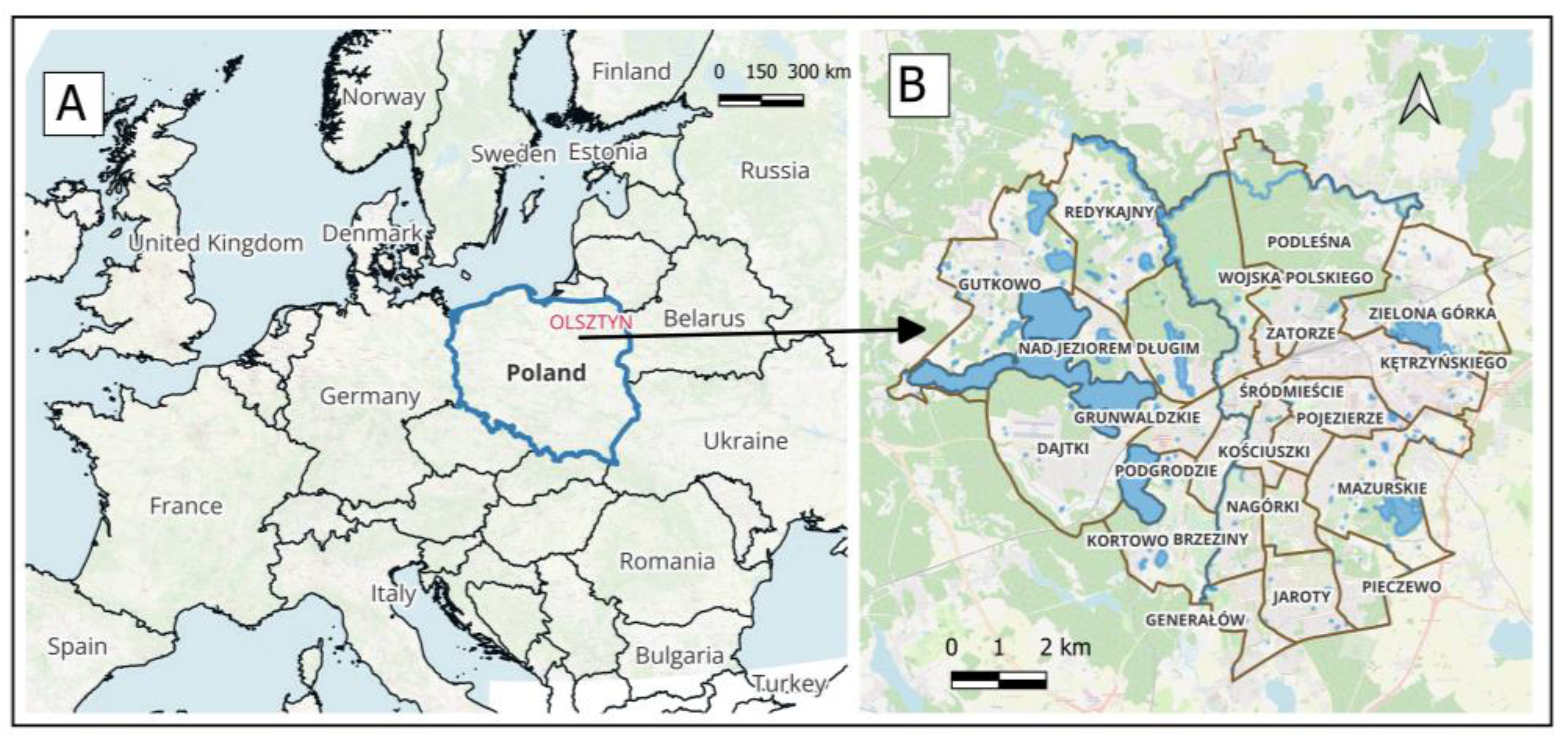
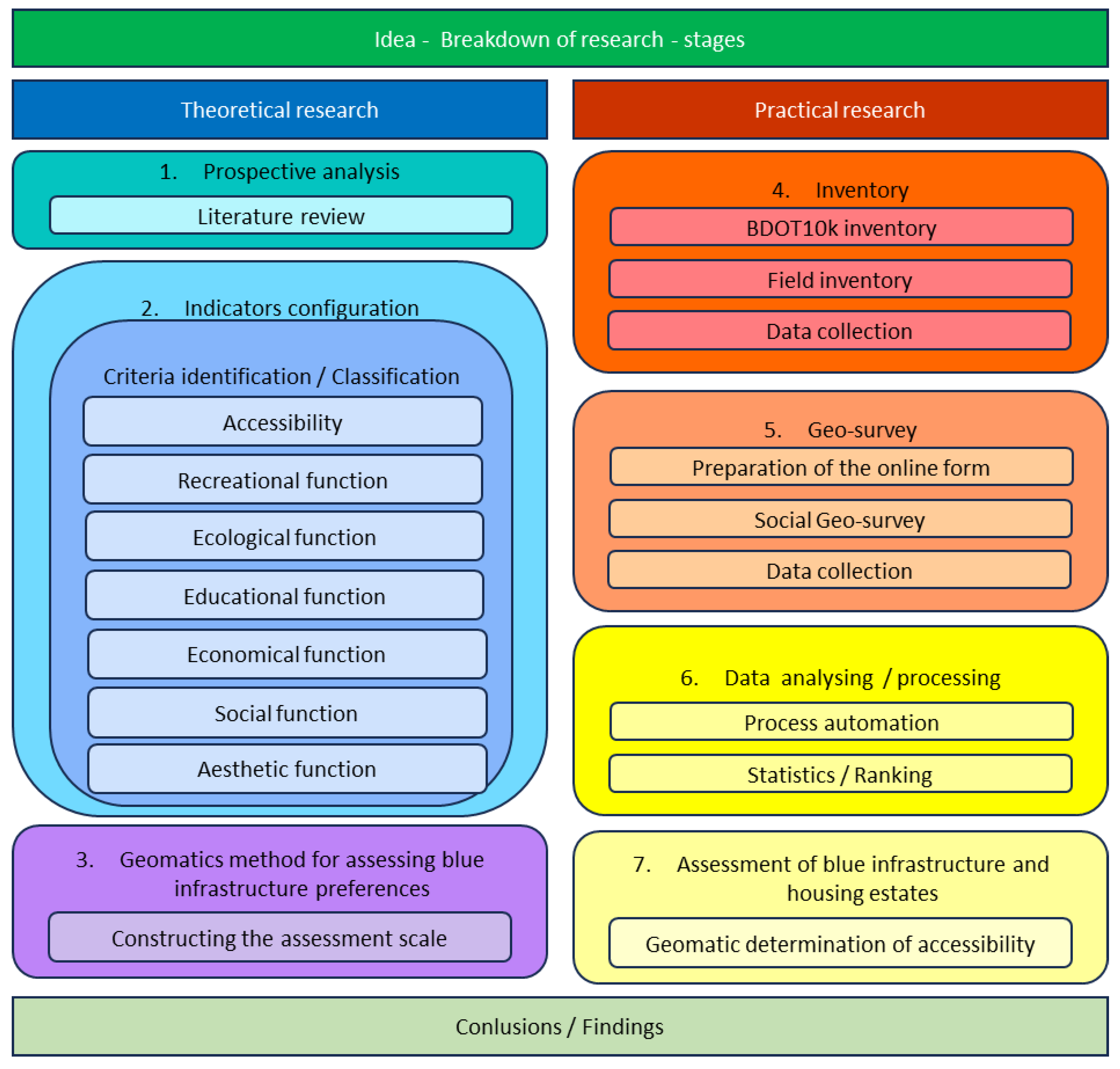

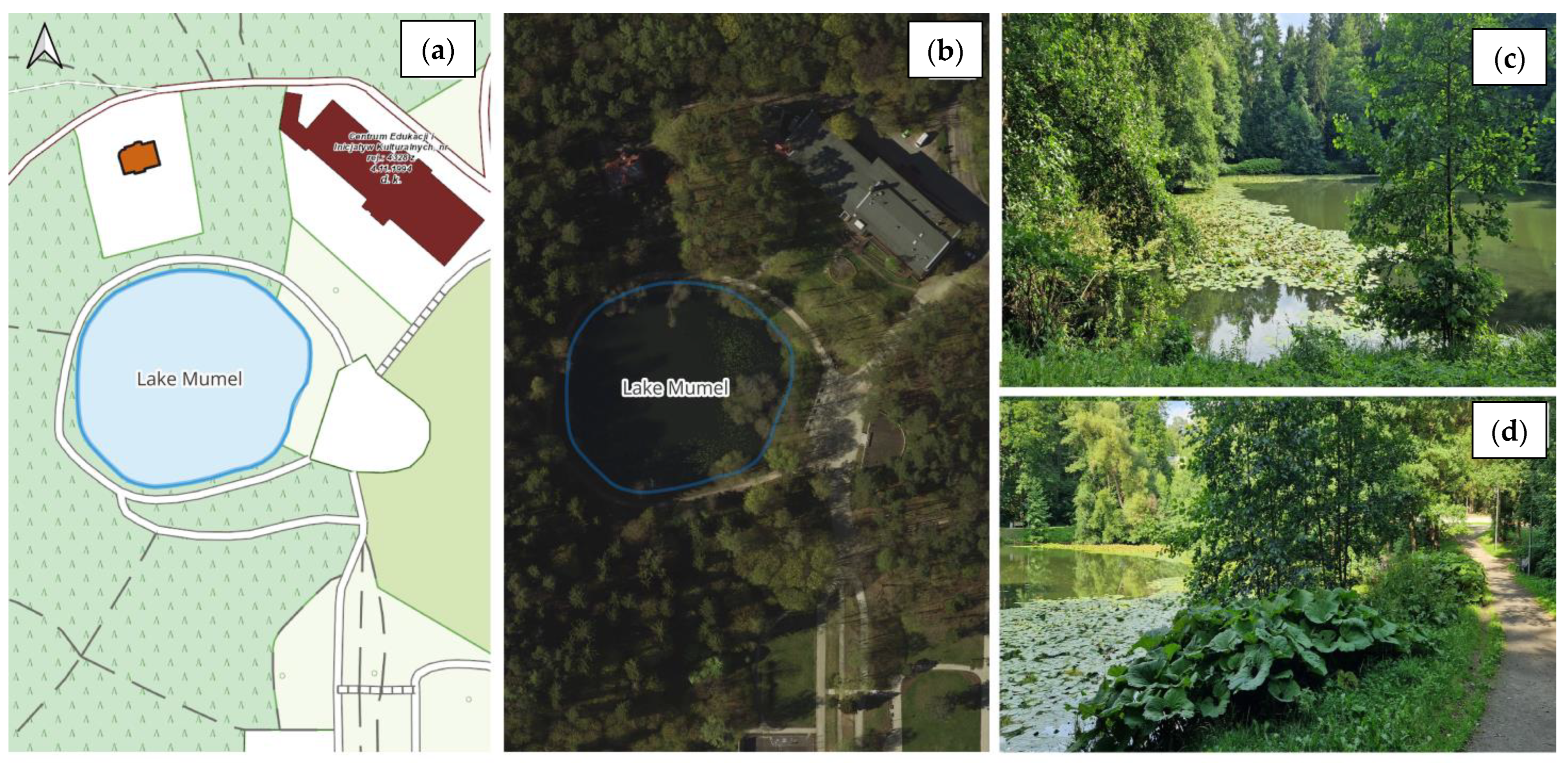
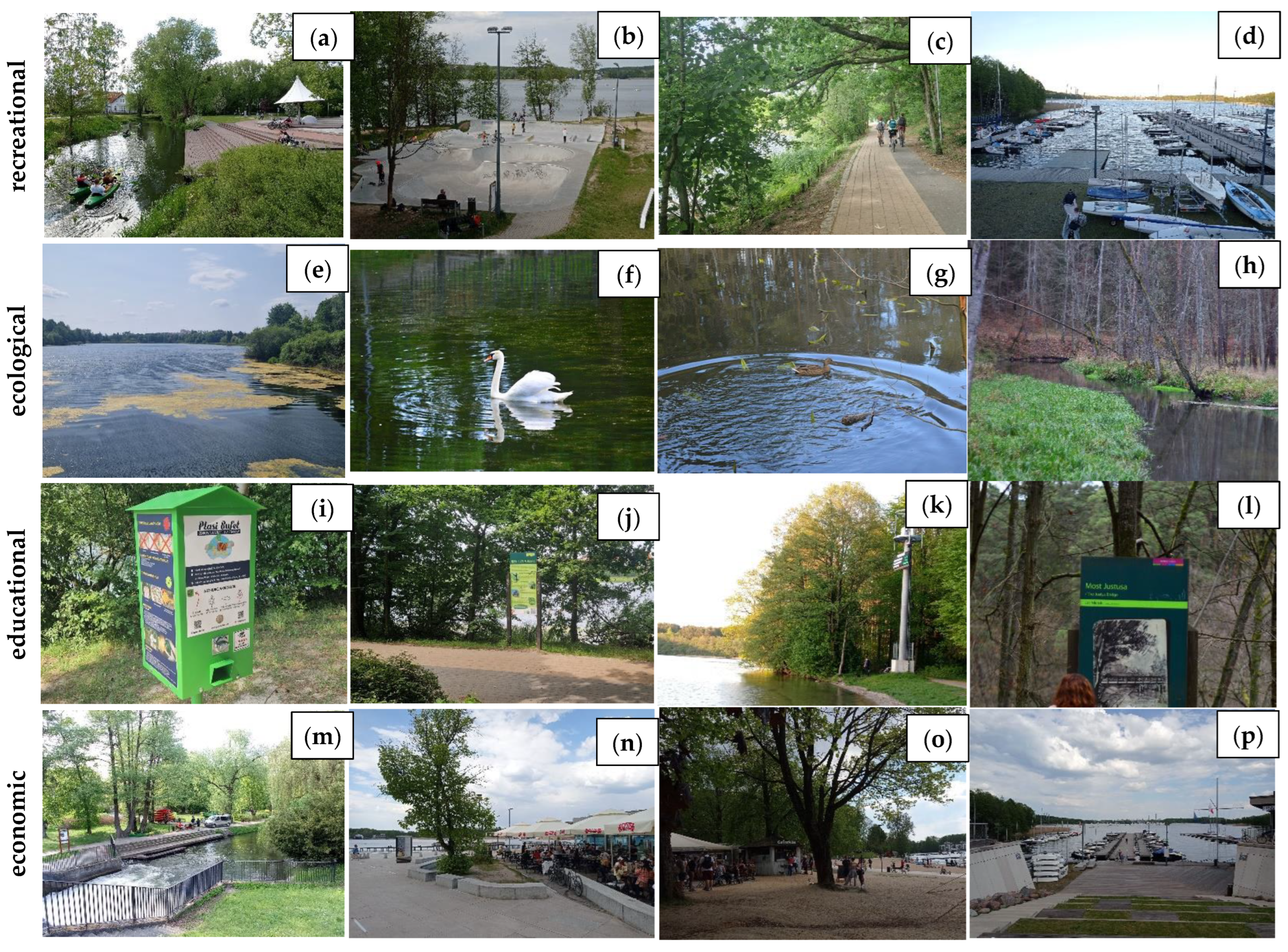
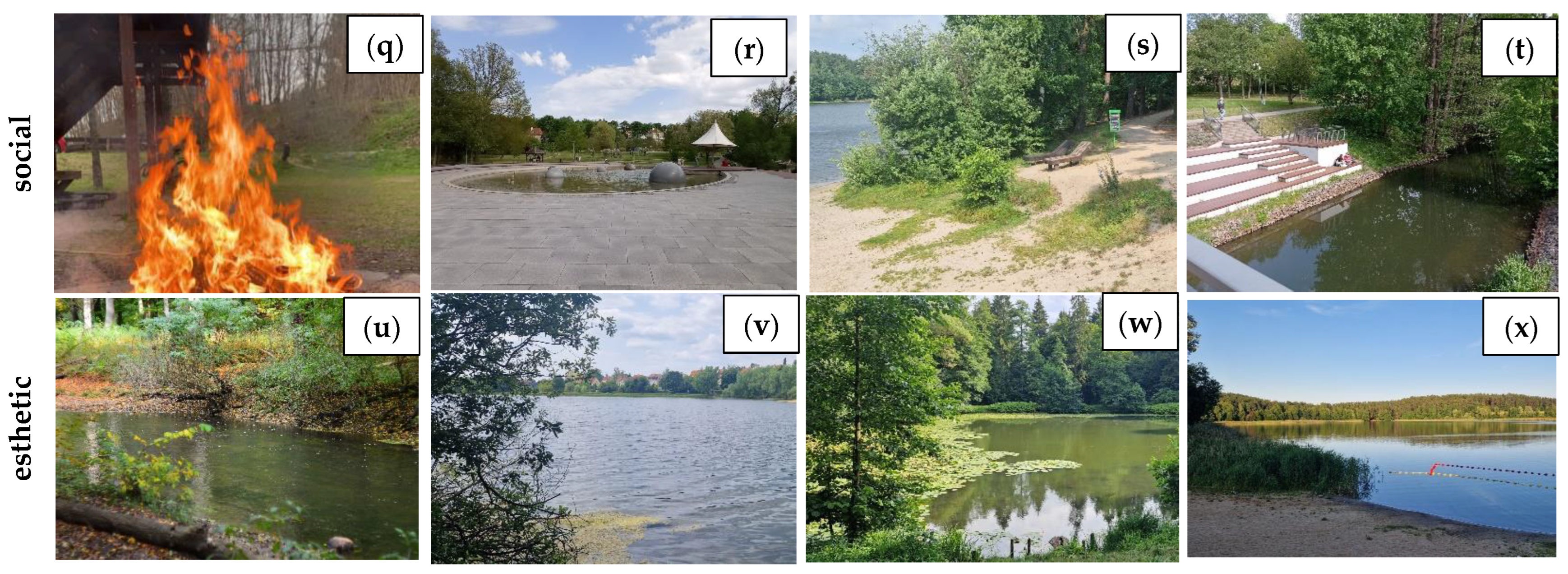
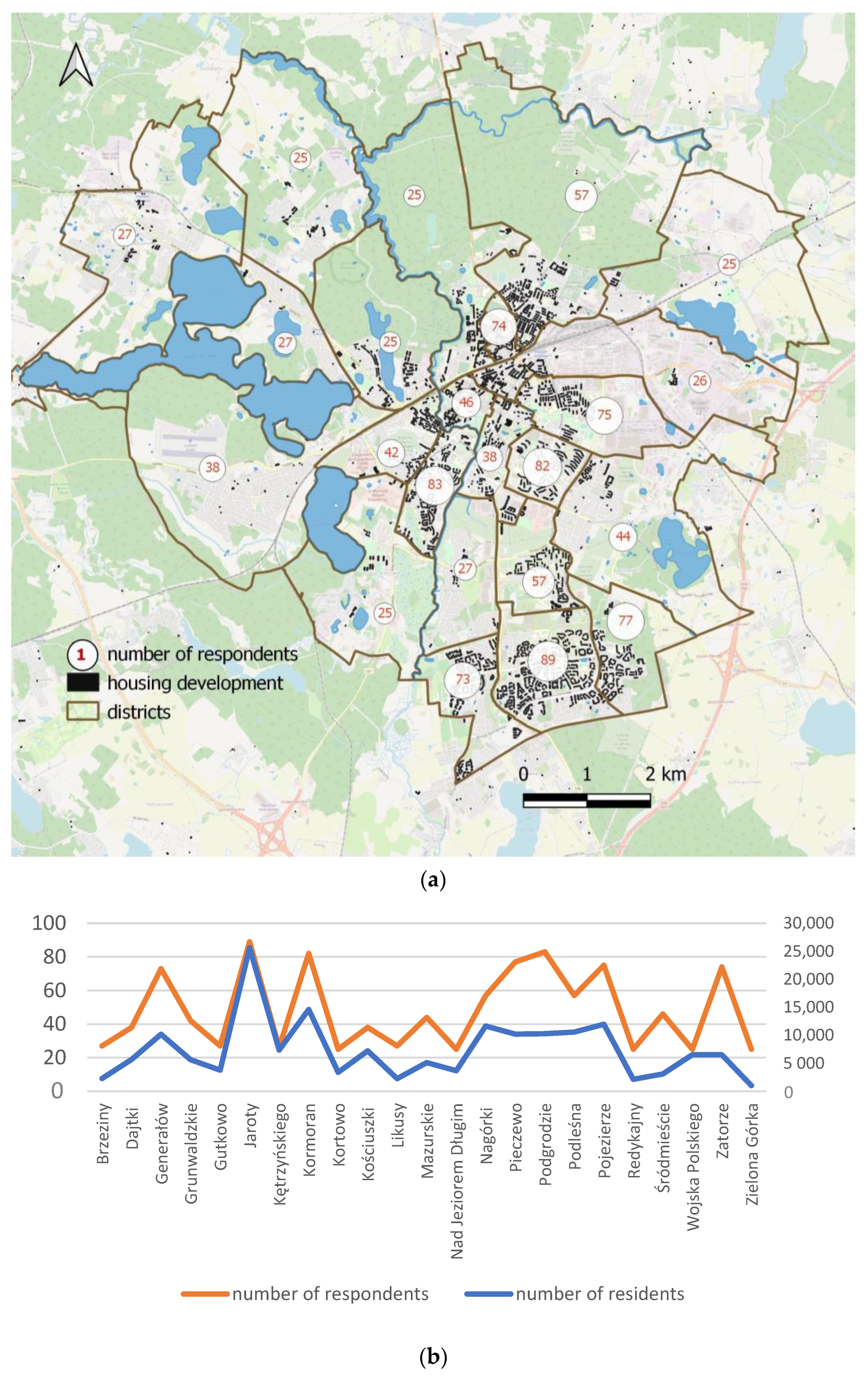
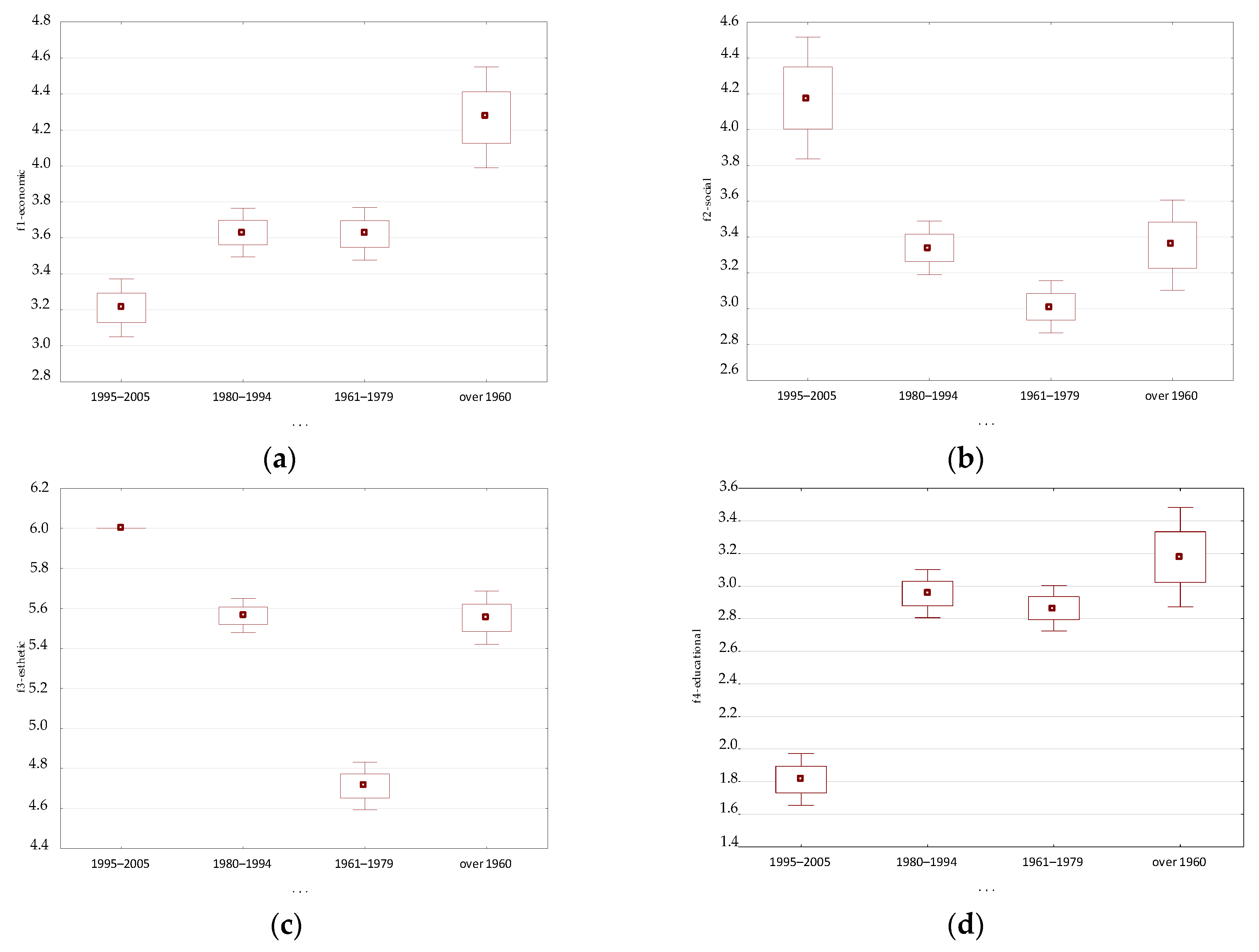
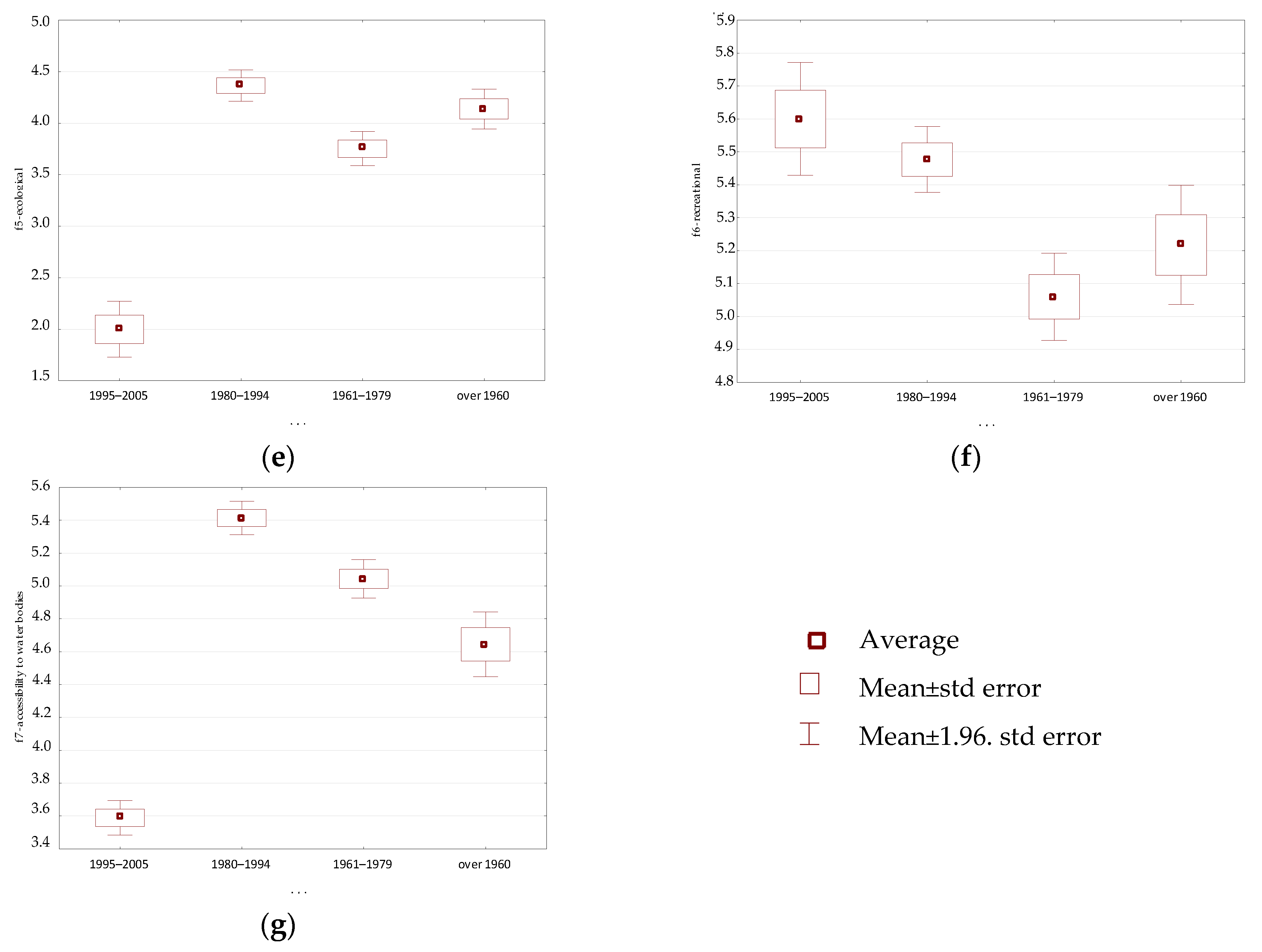
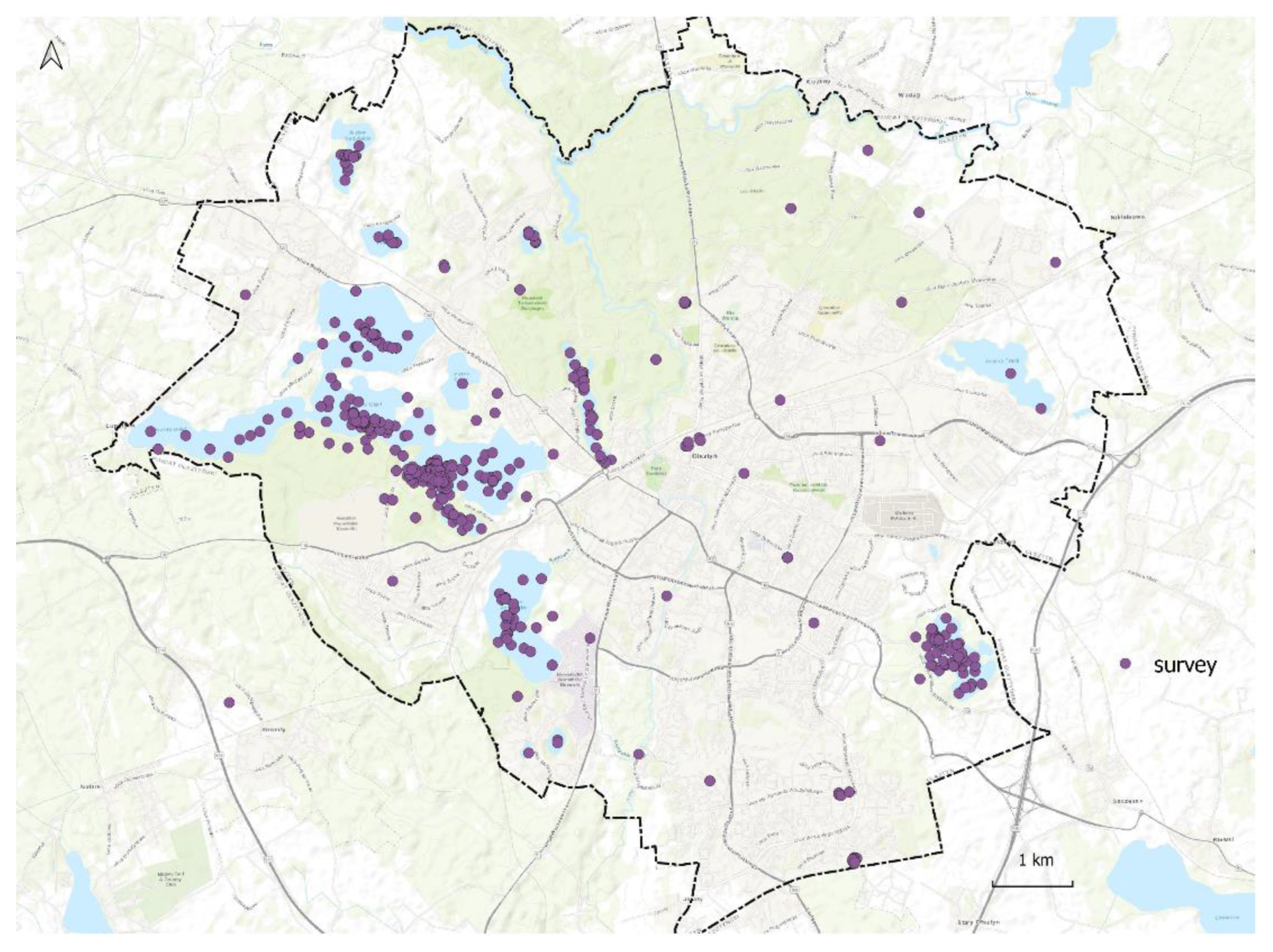

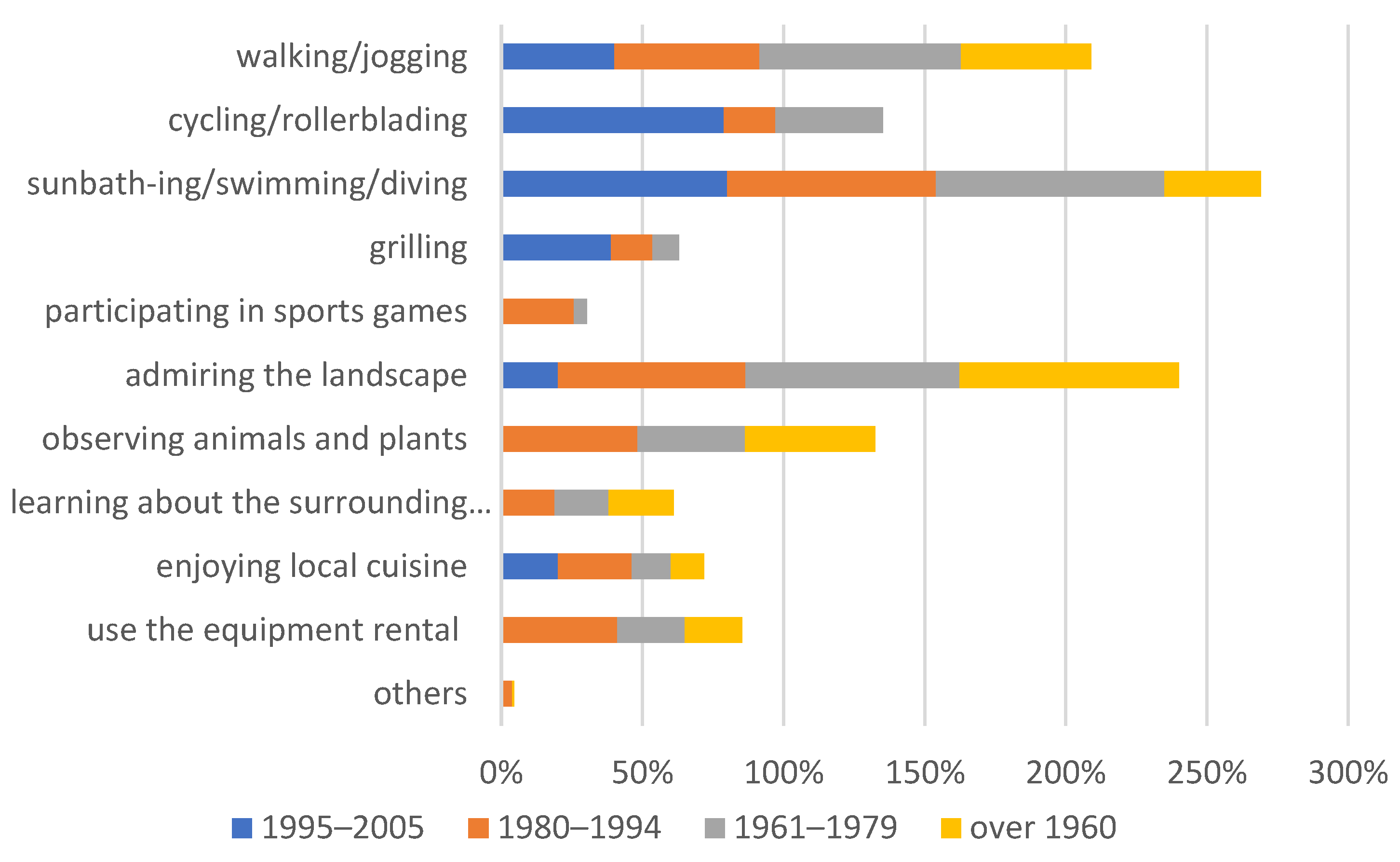
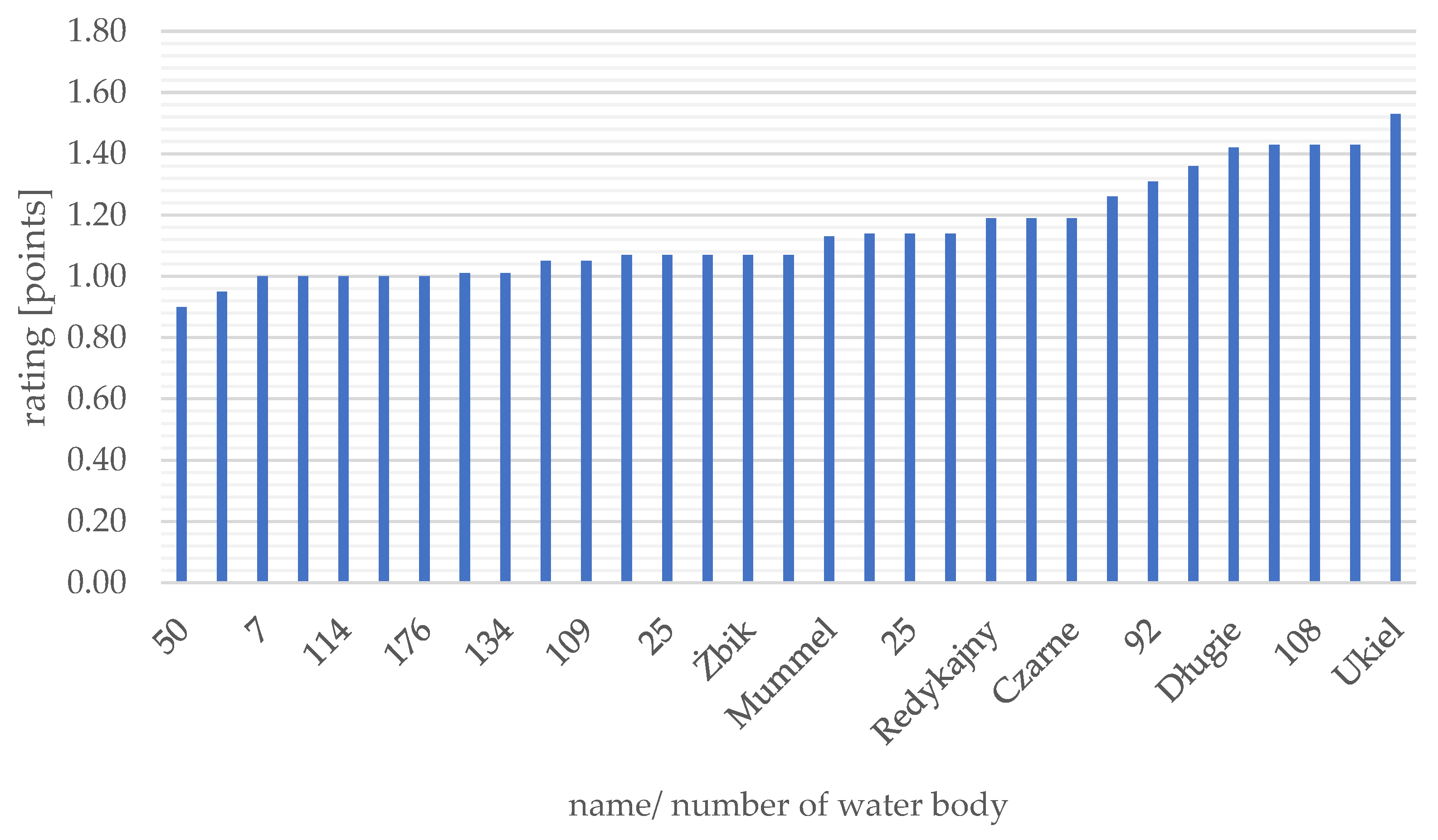

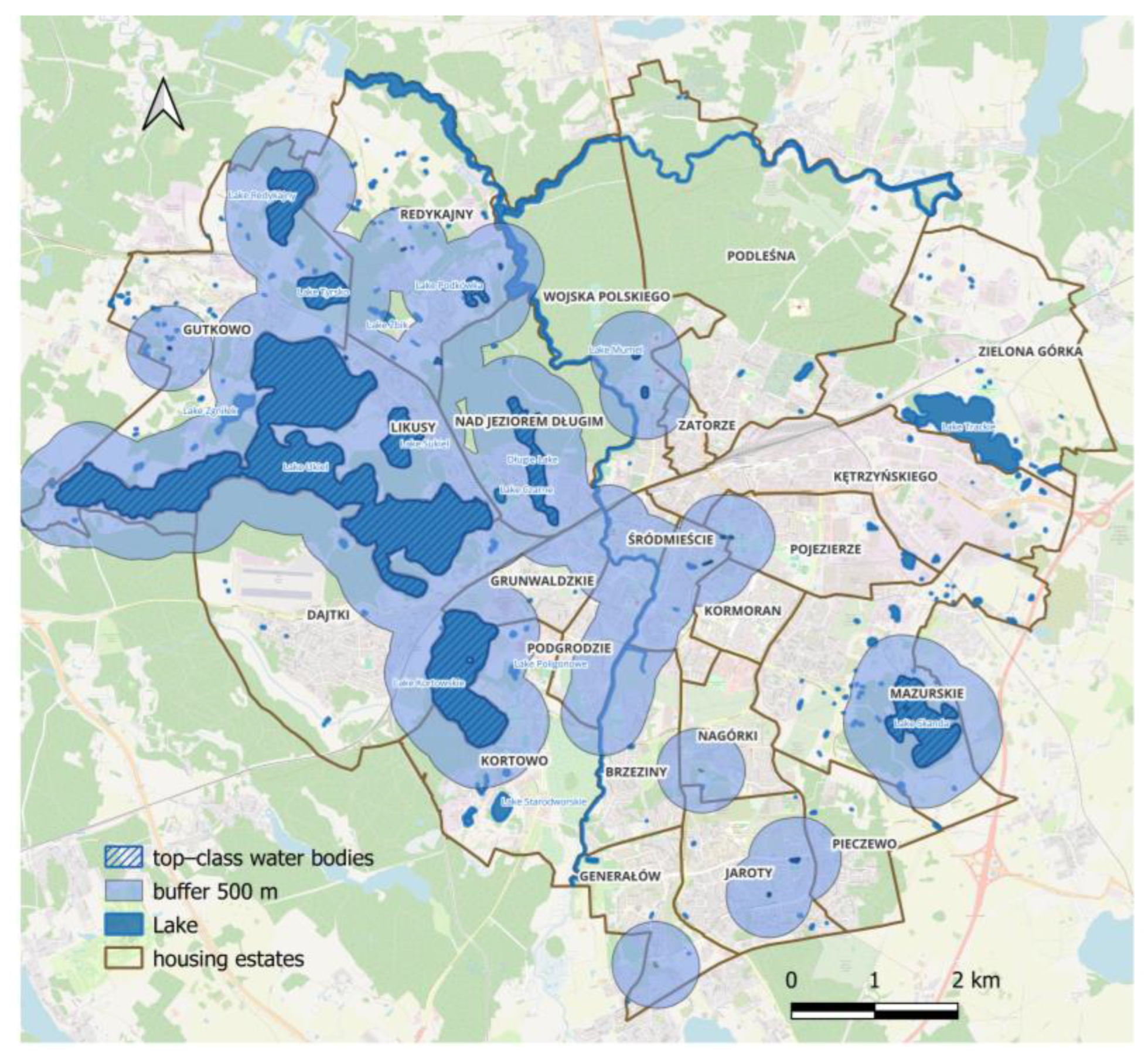
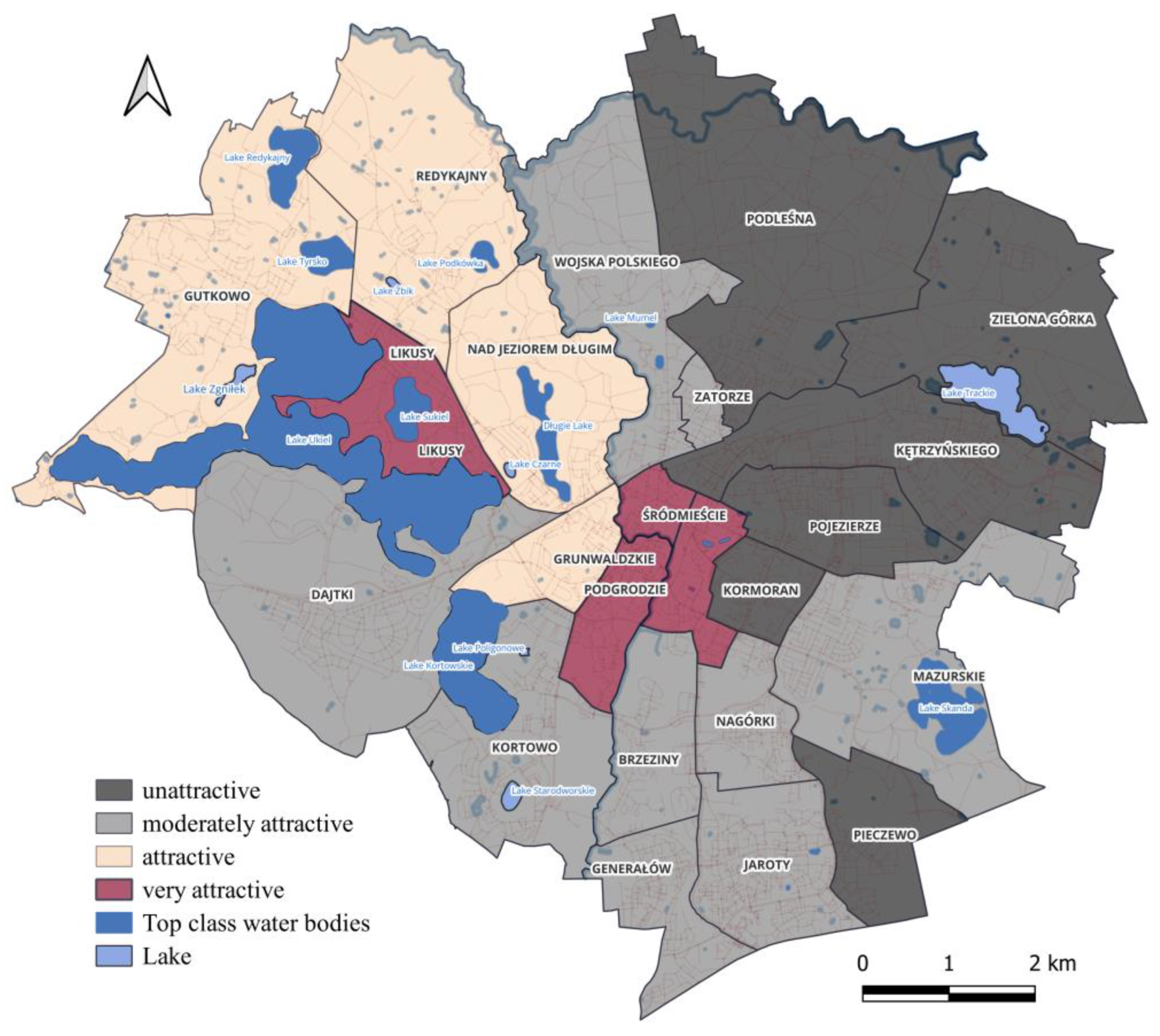
| Type of Land Use | Area (ha) | Coverage (%) |
|---|---|---|
| agricultural areas | 2119 | 25.8 |
| wooded and shrub land | 2013 | 23.0 |
| residential areas | 996 | 23.0 |
| industrial and storage areas | 1199 | 6.3 |
| parks and green areas | 479 | 2.0 |
| general urban services areas (including railways) | 1166 | 9.2 |
| lands under water | 852 | 10.7 |
| city area (Total) | 8824 | 100.0 |
| Name of Civic Budget Project | Type of Project | Location | Funding (EUR) | Project Description | Strengthening Functional Qualities |
|---|---|---|---|---|---|
| ‘Green Me’ Slightly larger pocket park. Pond of rethinking. | neighborhood project | Jaroty housing estate | 92,112 | Creation of a Pocket Park around the Thinking Pond—Adaptation and Modernization of a green area of public space. | esthetic function, recreational function |
| Redevelopment of the skatepark on the city beach | municipal project | On Ukiel Lake | 184,224 | Extension of the skatepark on the city beach in Olsztyn. Adding another part of the skatepark to the existing one to enlarge the riding area with new obstacles. | recreational function |
| ‘Concerts in Jakubowo Park—Culture in the Park’ | neighborhood project | Wojska Polskiego housing estate | 11,514 | The refurbished stage at the pond, which includes an electrical box, and offers a great opportunity to use the venue for concerts with local and invited artists to bring the community together. | social function |
| Dances in Jakubowo Park—Culture in the Park | neighborhood project | Wojska Polskiego housing estate | 11,514 | The refurbished stage, which has an electrical box next to it, provides ample opportunity to use the venue for a number of social gatherings with local dance music artists to organize dances. | social function |
| Save Długie Lake 3 | neighborhood project | on Długie Lake | 27,634 | The object of the task is to clean Lake Długie of excessive biomass of submerged vegetation and mats of filamentous algae. The ecological, esthetic, and recreational qualities will be improved. | ecological function, esthetic function, recreational function |
| ŁYNOSTRADA GROVE—construction of a footpath in Podgrodzie | neighborhood project | Podgrodzie housing estate | 56,516 | The area along Korczaka Street is a site with the potential for a small park. Meadows along the water channel, a dog run, and fruit trees have been designed—the aim is to create a new green spot on the city map. | esthetic function, recreational function, social function |
| Functions of Water Reservoirs | Average Value of the Function | Median | Minimum (Obtained) | Maximum (Obtained) | Standard Deviation |
|---|---|---|---|---|---|
| f1-economic (possibility of using catering services, accommodations) services, water equipment rental) | 3.68 | 3 | 1 | 6 | 1.49 |
| f2—social (presence of shelters/pavilions, places for grilling/bonfires, and benches) | 3.3 | 3 | 1 | 6 | 1.59 |
| f3—esthetic (landscape significance) | 5.29 | 6 | 3 | 6 | 1.08 |
| f4—educational (educational information nearby the water body) | 2.86 | 3 | 1 | 6 | 1.57 |
| f5—ecological (diversity of fauna and flora) | 3.94 | 4 | 1 | 6 | 1.7 |
| f6—recreational (opportunities for swimming, water sports, fishing, relaxation, cycling, and walking around the lake, etc.) | 5.31 | 6 | 2 | 6 | 1.17 |
| f7—accessibility to water bodies | 5.03 | 6 | 3 | 6 | 1.22 |
| Lake | Residential Neighborhood |
|---|---|
| Ukiel | 15 housing estates, i.e., Dajtki, Gutkowo, Generałów, Jaroty, Pieczewo, Podgrodzie, Redykajny, Śródmieście, Wojska Polskiego, Zatorze |
| Kortowskie | Generałów, Kortowo, Podgrodzie, Pojezierze |
| Skanda | 10 housing estates, i.e., Generałów, Jaroty, Kormoran, Mazurskie, Pieczywo, Podgrodzie, Pojezierze, Olsztyn’s neighborhood, Zatorze |
| Długie | 7 housing estates, i.e., Kortowo, Nad Jeziorem Długim, Podgrodzie, Podleśna, Śródmieście, Wojska Polskiego |
| Żbik | 1 housing estate: Likusy |
| Wadąg | Residential neighborhoods in the vicinity of Olsztyn |
| Bartążek | Generałów, Brzeziny |
| Value | Distance (km) |
|---|---|
| mean | 3.357774 |
| minimal | 0.740425 |
| maximal | 10.74031 |
| median | 3.003056 |
| Value Ranges | Number of Water Bodies | Percentage of Total Number of Water Bodies (%) | Name of the Lake | Water Body Number |
|---|---|---|---|---|
| 0–0.170 | 44 | 22 | - | 72, 125, 153, 165, 186, 187, 81, 15, 65, 44, 141, 63, 82, 13, 142, 147, 137, 77, 3, 133, 129, 93, 57, 189, 130, 43, 149, 66, 86, 42, 111, 45, 97, 19, 52, 128, 120, 96, 197, 34, 33, 11, 188 |
| 0.171–0.490 | 39 | 20 | Zgniłek | 73, 152, 177, 12, 23, 59, 124, 74, 58, 27, 41, 60, 78, 80, 112, 122, 151, 158, 161, 173, 195, 163, 91, 144, 126, 69, 135, 88, 40, 193, 76, 160, 110, 47, 167, 14, 150, 123, 99, 157, 105, 67, 61, 48, 54, 148 |
| 0.491–0.900 | 86 | 43 | Trackie, Starodworskie, Poligonowe, Żbik | 48, 54, 148, 71, 87, 100, 106, 118, 159, 190, 90, 9, 198, 16, 172, 196, 119, 10, 55, 84, 20, 85, 132, 56, 64, 31, 155, 5, 26, 98, 140, 175, 199, 139, 17, 181, 24, 2, 192, 4, 89, 185, 70, 194, 162, 138, 164, 79, 162, 22, 191, 171 |
| 0.901–1.530 | 30 | 15 | Ukiel, Długie, Skanda, Czarne, Redykajny, Łyna, Podkówka, Kortowskie, Sukiel | 50, 22, 7, 101, 114, 134, 134, 49, 109, 38, 25, 176, 25, 103, 92, 102, 108, 39 |
| Function | Weight | Characteristic | Number of Water Bodies | % of Water Bodies |
|---|---|---|---|---|
| Recreational | 0.187 | lack | 128 | 64.3 |
| partial outside of the reservoir (fishing, cycling, rollerblading, sunbathing, etc.) | 51 | 25.6 | ||
| partial inside the tank (swimming, swimming, the possibility of using water equipment, etc.) | 20 | 10.1 | ||
| full (external and internal) | 11 | 5.5 | ||
| Ecological | 0.125 | degraded tank | 22 | 11.1 |
| non-degraded tank | 177 | 88.9 | ||
| Educational | 0.094 | lack | 185 | 93.0 |
| educational paths/information boards | 14 | 7.0 | ||
| Economic | 0.125 | lack | 174 | 87.4 |
| proximity to business (gastronomy, accommodations, water equipment, etc. | 25 | 12.6 | ||
| Social | 0.094 | lack | 170 | 85.4 |
| public places for social integration (fireplace, grill, shed, etc.) | 29 | 14.6 | ||
| Esthetic | 0.187 | neglected reservoir | 73 | 36.7 |
| a reservoir with a small viewing opening that does not sufficiently emphasize the beauty of the landscape | 97 | 48.7 | ||
| tank of high esthetic value | 29 | 14.6 | ||
| Accessibility to the reservoir | 0.187 | lack | 68 | 34.2 |
| partial | 76 | 38.2 | ||
| full | 55 | 27.6 |
Disclaimer/Publisher’s Note: The statements, opinions and data contained in all publications are solely those of the individual author(s) and contributor(s) and not of MDPI and/or the editor(s). MDPI and/or the editor(s) disclaim responsibility for any injury to people or property resulting from any ideas, methods, instructions or products referred to in the content. |
© 2023 by the authors. Licensee MDPI, Basel, Switzerland. This article is an open access article distributed under the terms and conditions of the Creative Commons Attribution (CC BY) license (https://creativecommons.org/licenses/by/4.0/).
Share and Cite
Dudzińska, M.; Dawidowicz, A.; Gross, M. How Does Blue Infrastructure Affect the Attractiveness Rating of Residential Areas? Case Study of Olsztyn City, Poland. Sustainability 2023, 15, 16843. https://doi.org/10.3390/su152416843
Dudzińska M, Dawidowicz A, Gross M. How Does Blue Infrastructure Affect the Attractiveness Rating of Residential Areas? Case Study of Olsztyn City, Poland. Sustainability. 2023; 15(24):16843. https://doi.org/10.3390/su152416843
Chicago/Turabian StyleDudzińska, Małgorzata, Agnieszka Dawidowicz, and Marta Gross. 2023. "How Does Blue Infrastructure Affect the Attractiveness Rating of Residential Areas? Case Study of Olsztyn City, Poland" Sustainability 15, no. 24: 16843. https://doi.org/10.3390/su152416843
APA StyleDudzińska, M., Dawidowicz, A., & Gross, M. (2023). How Does Blue Infrastructure Affect the Attractiveness Rating of Residential Areas? Case Study of Olsztyn City, Poland. Sustainability, 15(24), 16843. https://doi.org/10.3390/su152416843









